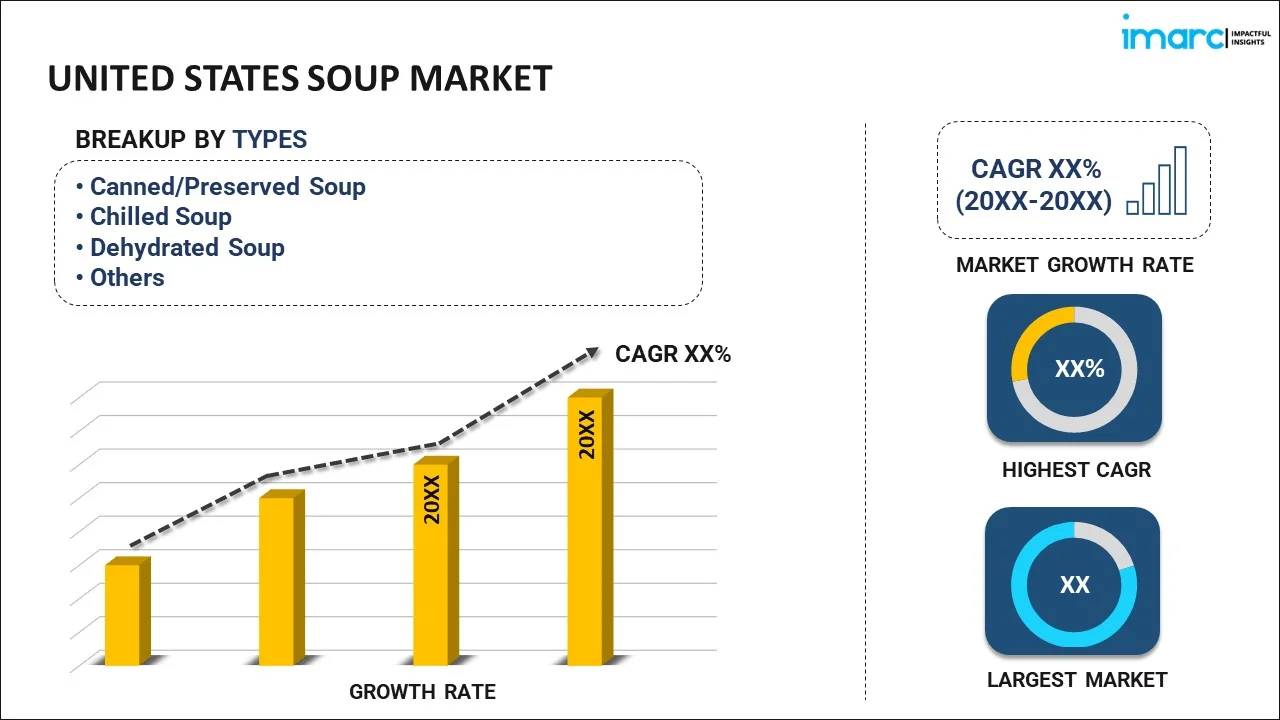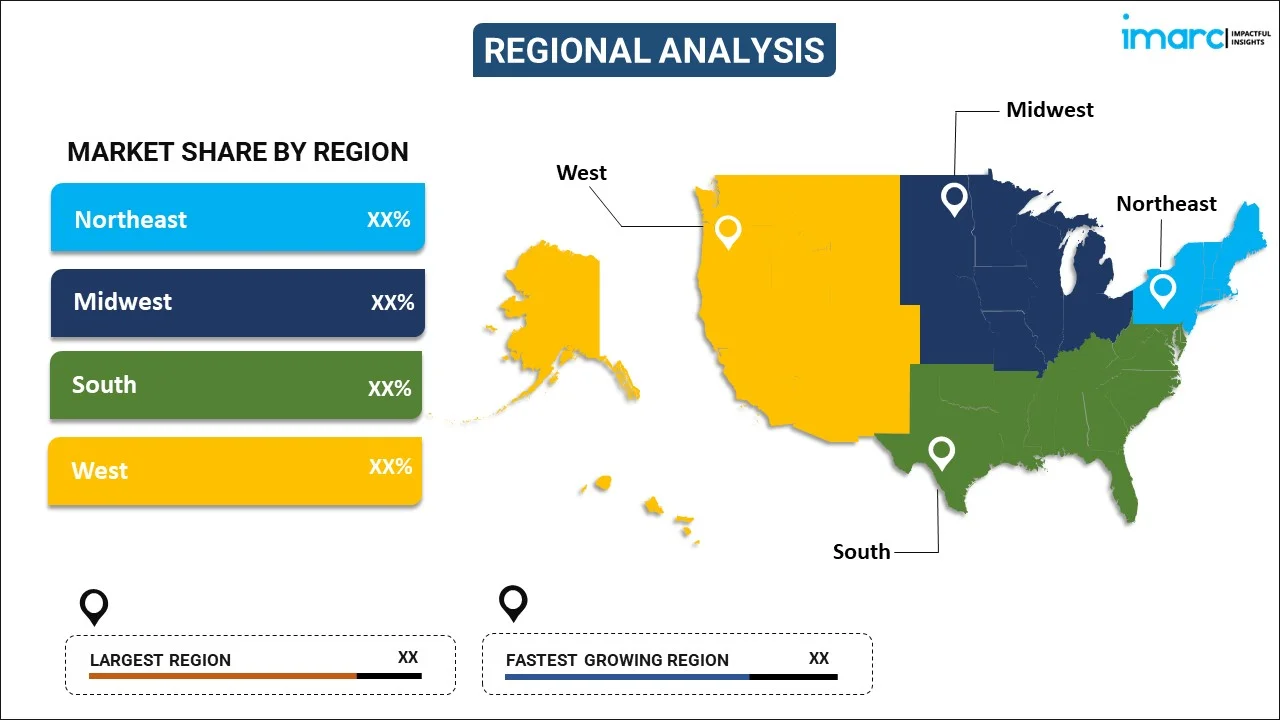
United States Soup Market Report by Type (Canned/Preserved Soup, Chilled Soup, Dehydrated Soup, Frozen Soup, UHT Soup), Category (Vegetarian Soup, Non-Vegetarian Soup), Packaging (Canned, Pouched, and Others), Distribution Channels (Supermarkets and Hypermarkets, Convenience Stores, Online Stores, and Others), and Region 2025-2033
Market Overview:
The United States soup market size reached USD 2.9 Billion in 2024. Looking forward, IMARC Group expects the market to reach USD 3.5 Billion by 2033, exhibiting a growth rate (CAGR) of 1.8% during 2025-2033. The increasing consumer health consciousness favoring nutrient-rich soup variants, escalating demand for convenience foods due to fast-paced lifestyles, and a surge in product innovation delivering a wide array of flavors and dietary options represent some of the key factors driving the market.
|
Report Attribute
|
Key Statistics
|
|---|---|
|
Base Year
|
2024 |
|
Forecast Years
|
2025-2033
|
|
Historical Years
|
2019-2024
|
| Market Size in 2024 | USD 2.9 Billion |
| Market Forecast in 2033 | USD 3.5 Billion |
| Market Growth Rate (2025-2033) | 1.8% |
Soup is a primarily liquid food, often served warm or hot, that is made by combining various ingredients of meat or vegetables with stock, juice, water, or another liquid. It is a culinary staple with a ubiquitous presence in diverse cuisines, making it an integral part of gastronomic traditions worldwide. This versatile dish can be crafted from virtually any combination of ingredients in a liquid medium. Depending on the preparation, soup may serve as an appetizer, a side dish, or a main course. Its consistency can range from a light, clear broth to a thick, hearty stew, showcasing the depth of its potential forms. Nutritionally, soup is highly adaptable to dietary needs and preferences, offering a platform for healthy, balanced meals. It is typically low in fat and packed with nutrients from vegetables, lean meats, and pulses. Its high-water content aids in hydration and a feeling of satiety, supporting weight management efforts. Commercially, soups are available in canned or dried forms for convenience. As a result, soup has gained immense traction as a popular food item in modern, fast-paced societies.
United States Soup Market Trends:
At present, the increasing health consciousness among consumers across the United States represents the primary factor driving the market growth. As individuals become more aware of the benefits of a balanced diet, they are turning toward nutrient-rich food items. Since soups are generally loaded with vegetables, lean proteins, and fiber, they are perceived as healthy meal options. Moreover, the convenience of pre-packaged, ready-to-eat (RTE), and easy-to-prepare soup variants is gaining popularity, particularly among urban consumers. In line with this, busy lifestyles and hectic schedules of the working population have augmented the demand for convenience foods like soup in the region. Additionally, continual innovation in flavors, ingredients, and types of soup is supporting the market growth. The leading manufacturers are experimenting with exotic flavors and catering to different dietary preferences, such as vegan, gluten-free, organic, and low-sodium soups. Besides this, soup consumption in the United States is notably seasonal, with demand typically escalating during the colder months. This weather-driven trend is another major growth-inducing factor. Furthermore, easy access to a wide variety of soup brands and products through e-commerce platforms has catalyzed market growth. Consumers can conveniently shop for a broad range of options and have them delivered directly to their homes. Other factors, including the launch of plant-based soup varieties, elevating sales of RTE foods, and increasing consumer focus on health and wellness, are also anticipated to provide a positive thrust to the market growth.
United States Soup Industry Segmentation:
IMARC Group provides an analysis of the key trends in each segment of the United States soup market report, along with forecasts at the country level for 2025-2033. Our report has categorized the market based on type, category, packaging, and distribution channel.
Breakup by Type:

- Canned/Preserved Soup
- Chilled Soup
- Dehydrated Soup
- Frozen Soup
- UHT Soup
The report has provided a detailed breakup and analysis of the market based on the type. This includes canned/preserved soup, chilled soup, dehydrated soup, frozen soup, and UHT soup.
Breakup by Category:
- Vegetarian Soup
- Non-Vegetarian Soup
A detailed breakup and analysis of the market based on the category has also been provided in the report. This includes vegetarian soup and non-vegetarian soup.
Breakup by Packaging:
- Canned
- Pouched
- Others
The report has provided a detailed breakup and analysis of the market based on the packaging. This includes canned, pouched, and others.
Breakup by Distribution Channel:
- Supermarkets and Hypermarkets
- Convenience Stores
- Online Stores
- Others
A detailed breakup and analysis of the market based on the distribution channel has also been provided in the report. This includes supermarkets and hypermarkets, convenience stores, online stores, and others.
Breakup by Region:

- Northeast
- Midwest
- South
- West
The report has also provided a comprehensive analysis of all the major regional markets, which include Northeast, Midwest, South, and West.
Competitive Landscape:
The report has also provided a comprehensive analysis of the competitive landscape in the United States soup market. Competitive analysis such as market structure, key player positioning, top winning strategies, competitive dashboard, and company evaluation quadrant has been covered in the report. Also, detailed profiles of all major companies have been provided.
United States Soup Market Report Scope:
| Report Features | Details |
|---|---|
| Base Year of the Analysis | 2024 |
| Historical Period | 2019-2024 |
| Forecast Period | 2025-2033 |
| Units | Billion USD |
| Scope of the Report | Exploration of Historical and Forecast Trends, Industry Catalysts and Challenges, Segment-Wise Historical and Predictive Market Assessment:
|
| Types Covered | Canned/Preserved Soup, Chilled Soup, Dehydrated Soup, Frozen Soup, UHT Soup |
| Categories Covered | Vegetarian Soup, Non-Vegetarian Soup |
| Packagings Covered | Canned, Pouched, Others |
| Distribution Channels Covered | Supermarkets and Hypermarkets, Convenience Stores, Online Stores, Others |
| Regions Covered | Northeast, Midwest, South, West |
| Customization Scope | 10% Free Customization |
| Post-Sale Analyst Support | 10-12 Weeks |
| Delivery Format | PDF and Excel through Email (We can also provide the editable version of the report in PPT/Word format on special request) |
Key Questions Answered in This Report:
- How has the United States soup market performed so far and how will it perform in the coming years?
- What has been the impact of COVID-19 on the United States soup market?
- What is the breakup of the United States soup market on the basis of type?
- What is the breakup of the United States soup market on the basis of category?
- What is the breakup of the United States soup market on the basis of packaging?
- What is the breakup of the United States soup market on the basis of distribution channel?
- What are the various stages in the value chain of the United States soup market?
- What are the key driving factors and challenges in the United States soup market?
- What is the structure of the United States soup market and who are the key players?
- What is the degree of competition in the United States soup market?
Key Benefits for Stakeholders:
- IMARC’s report offers a comprehensive quantitative analysis of various market segments, historical and current market trends, market forecasts, and dynamics of the United States soup market from 2019-2033.
- The research study provides the latest information on the market drivers, challenges, and opportunities in the United States soup market.
- Porter's five forces analysis assist stakeholders in assessing the impact of new entrants, competitive rivalry, supplier power, buyer power, and the threat of substitution. It helps stakeholders to analyze the level of competition within the United States soup industry and its attractiveness.
- Competitive landscape allows stakeholders to understand their competitive environment and provides an insight into the current positions of key players in the market.
Need more help?
- Speak to our experienced analysts for insights on the current market scenarios.
- Include additional segments and countries to customize the report as per your requirement.
- Gain an unparalleled competitive advantage in your domain by understanding how to utilize the report and positively impacting your operations and revenue.
- For further assistance, please connect with our analysts.
 Inquire Before Buying
Inquire Before Buying
 Speak to an Analyst
Speak to an Analyst
 Request Brochure
Request Brochure
 Request Customization
Request Customization




.webp)




.webp)












